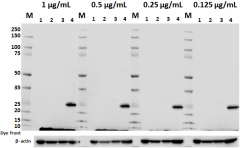- Clone
- M0410B2 (See other available formats)
- Regulatory Status
- RUO
- Other Names
- Lipocalin 2, Oncogene 24p3, Neutrophil Gelatinase-Associated Lipocalin, Siderocalin LCN2, 25 kD Alpha-2-Microglobulin-Related Subunit Of MMP-9, p25, MSFI, Migration-Stimulating Factor Inhibitor, HNL
- Isotype
- Rat IgG2a, κ
- Ave. Rating
- Submit a Review
- Product Citations
- publications

-

Cell lysate from A431 human cell line (lane 1), NIH3T3 mouse cell line (lane 2), mouse pancreas (lane 3) and mouse bone marrow (lane 4) (15 µg protein for each) were resolved by 4-12% Bis-Tris gel electrophoresis, transferred to nitrocellulose, and probed with 0.125 - 1 µg/mL of Purified anti-NGAL (Lipocalin-2) Antibody (clone M0410B2) (upper). Proteins were visualized using chemiluminescence detection after incubation with a 1:3000 dilution of HRP conjugated anti-rat-IgG secondary antibody for the anti-NGAL (upper panel) antibody or a 1:5000 dilution of Direct-Blot™ HRP anti-β-Actin (clone 2F1-1, lower panel). Lane M: Molecular weight ladder.
| Cat # | Size | Price | Quantity Check Availability | Save | ||
|---|---|---|---|---|---|---|
| 661502 | 500 µg | £238 | ||||
NGAL (lipocalin-2) is a lipocalin family protein that plays important roles in innate immunity, inflammation, and atherosclerosis. Mouse NGAL is detected in lung, spleen, uterus, vagina, and epididymis. It is a critical component of innate immunity because of its ability to bind iron-siderophore complexes and limit bacterial growth. It is also produced by injured epithelia and is one of the most promising new markers for renal epithelial injury and cardiovascular disease (CVD).
Product DetailsProduct Details
- Verified Reactivity
- Mouse
- Antibody Type
- Monoclonal
- Host Species
- Rat
- Immunogen
- Recombinant mouse NGAL
- Formulation
- Phosphate-buffered solution, pH 7.2, containing 0.09% sodium azide.
- Preparation
- The antibody was purified by affinity chromatography.
- Concentration
- 0.5 mg/ml
- Storage & Handling
- The antibody solution should be stored undiluted between 2°C and 8°C.
- Application
-
WB - Quality tested
- Recommended Usage
-
Each lot of this antibody is quality control tested by Western blotting. For Western blotting, the suggested use of this reagent is 0.125 - 1.0 µg per ml. It is recommended that the reagent be titrated for optimal performance for each application.
- Product Citations
-
- RRID
-
AB_2563987 (BioLegend Cat. No. 661502)
Antigen Details
- Structure
- 195 amino acid monomer with a predicted molecular weight of approximately 23 kD.
- Distribution
-
Secreted by epithelial cells, macrophages, neutrophils; increased levels have been observed in plasma, serum, and urine in various conditions, such as metastatic breast and colorectal cancer, acute kidney injury, pancreatitis and preeclampsia.
- Function
- Apoptosis, innate immunity, renal development.
- Interaction
- Disulfide-linked with MMP9.
- Ligand/Receptor
- SLC22A17 (24p3R).
- Cell Type
- Epithelial cells, Macrophages, Neutrophils
- Biology Area
- Apoptosis/Tumor Suppressors/Cell Death, Cell Biology, Immunology, Innate Immunity, Signal Transduction
- Antigen References
-
1. Iqbal N, et al. 2013. Expert Opin. Med Diagn. 7:209.
2. Singer E, et al. 2013. Acta. Physiol. (Oxf) 207:663.
3. Palazzuoli A, et al. 2012. Clin. Chim. Acta. 413:1832.
4. Flo TH, et al. 2004. Nature 432:917.
5. Goetz DH, et al. 2002. Mol. Cell. 10:1033.
6. Leung L, et al. 2012. PLoS One 7:e46677.
7. Kjeldsen L, et al. 1993. J. Biol. Chem. 268:10425. - Gene ID
- 3934 View all products for this Gene ID
- UniProt
- View information about NGAL on UniProt.org
Related Pages & Pathways
Pages
Related FAQs
Other Formats
View All NGAL Reagents Request Custom Conjugation| Description | Clone | Applications |
|---|---|---|
| Purified anti-NGAL (Lipocalin-2) | M0410B2 | WB |
Compare Data Across All Formats
This data display is provided for general comparisons between formats.
Your actual data may vary due to variations in samples, target cells, instruments and their settings, staining conditions, and other factors.
If you need assistance with selecting the best format contact our expert technical support team.
-
Purified anti-NGAL (Lipocalin-2)

Cell lysate from A431 human cell line (lane 1), NIH3T3 mouse...

 Login / Register
Login / Register 







Follow Us